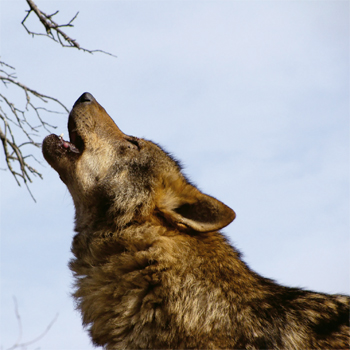Grey wolves (Canis lupus) are widespread across the Holarctic. Here, the previously proposed hypothesis that extant North American wolves originate from multiple waves of colonization from Asia is tested, along with the hypothesis that land connections have been important in the evolutionary history of other isolated wolf populations in Japan. Results suggest that the mitogenomes of all living wolves in North America, including Mexican wolves, most likely derive from a single colonization event from Eurasia that expanded the grey wolf range into North America. This colonization occurred while a land bridge connected Eurasia and North America before the Cordilleran and Laurentide ice sheets fused in the Last Glacial Maximum, c. 23 ka, much more recent than predicted based on the fossil record. Pleistocene land bridges also facilitated the separate colonization of Hokkaido and the southern Japanese islands. Extant wolf lineages in North America derive from wolves that migrated into North America coincident with the formation of the most recent land bridge with Eurasia. The maternal lineages from earlier Pleistocene American wolves are not represented in living American wolves, indicating that they left no descendants. The timing of colonization of North America, Hokkaido and the southern Japanese islands corresponds to the changes in land connectivity as a consequence of changing sea level. informacion[at]ebd.csic.es: Koblmüller et al (2016) Whole mitochondrial genomes illuminate ancient intercontinental dispersals of grey wolves (Canis lupus). J Biogeogr 43: 1728–1738. doi:10.1111/jbi.12765
http://onlinelibrary.wiley.com/doi/10.1111/jbi.12765/abstract  Latest News
Latest News
 Las altas temperaturas están provocando que las lagunas y las marismas de Doñana pierdan agua rápidamente
Las altas temperaturas están provocando que las lagunas y las marismas de Doñana pierdan agua rápidamente
La superficie inundada en la marisma es de un 78% pero la profundidad es escasa. Por otra parte, sólo el 1,9% de las lagunas temporales están inundadas. Las precipitaciones crean una oportunidad...
 Traffic noise causes lifelong harm to baby birds
Traffic noise causes lifelong harm to baby birds
A study with CSIC participation reveals for the first time that car noise harms individuals throughout their lifetime even years after exposure
 Illegal wildlife trade, a serious problem for biodiversity and human health
Illegal wildlife trade, a serious problem for biodiversity and human health
A research team led by the Doñana BIological Station and the University Pablo de Olavide have detected wild-caught pets in 95% of the localities in the Neotropic and warns of the risk of zoonotic...
 Urbanization and loss of woody vegetation are changing key traits of arthropod communities
Urbanization and loss of woody vegetation are changing key traits of arthropod communities
Urbanization is favouring smaller beetle species and larger spider species with greater dispersal capacity.
The loss of woody areas is linked to a decline in the duration of the activity...
The loss of woody areas is linked to a decline in the duration of the activity...
 Blood lead levels in an endangered vulture species decreased following restrictions on hunting practices
Blood lead levels in an endangered vulture species decreased following restrictions on hunting practices
Canarian Egyptian vulture was on the verge of extinction at the end of the 20th century. At that time, studies revealed that lead poisoning was a serious problem for the population’s survival. The...
— 5 Items per Page
 Asset Publisher
Asset Publisher
Back






